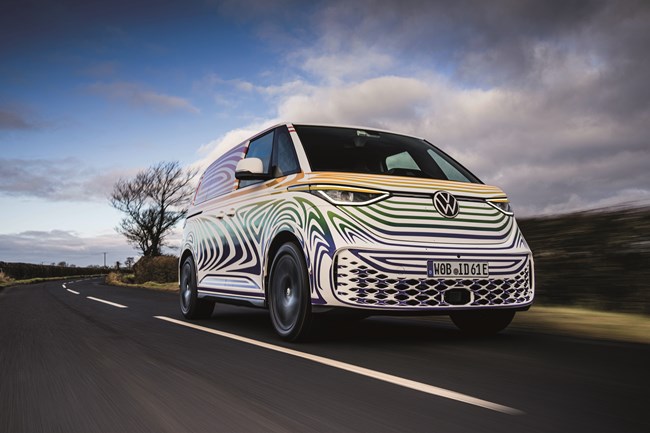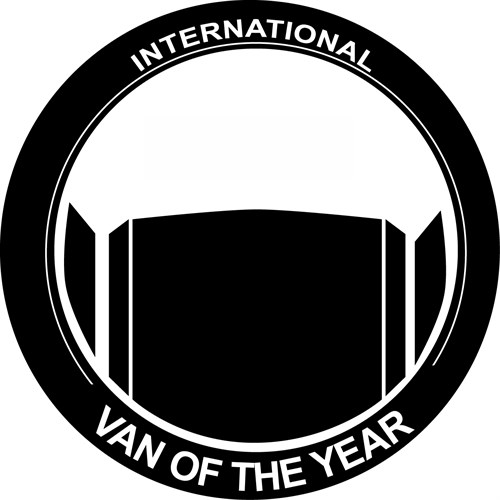- Renault gives UK debut to Master E-Tech at CV Show
- Isuzu D-Max long-term test – Latest Report
- Isuzu D-Max V-Cross Steel Edition revealed
- IVOTY Report: Stellantis explores the hydrogen proposition
- New Maxus EVs include eDeliver 5 van
- Used LCV values reach six-month high
- ADVERTISEMENT FEATURE: IVECO Daily Mission Awards 2024 Q2 Round-up: Grounds Maintenance & Forestry
- Stellantis Pro One electric vans review
- Mitie adds 5,000th EV to fleet
- Record number of CVs now on UK roads, SMMT reports
Volkswagen ID. Buzz Cargo prototype IVOTY review
Date: Monday, February 28, 2022 | Author: George Barrow
The ID. Buzz Cargo may sport trendy retro styling but it is Volkswagen’s first proper plug-in van.

Volkswagen hasn’t given us an electric commercial vehicle yet – well, not a proper one – but that’s all about to change with the ID. Buzz Cargo.
Think of it as a modern interpretation of the Type 2 van synonymous with campervans, which is a halfway house between the Caddy and the Transporter but with an electric powertrain.
Look past the swirling rainbow camouflage and you will see VW’s new halo product for an electric generation with passenger, campervan, and commercial vehicle versions of this compact but medium-sized van all scheduled to go into production. If you’re familiar with the passenger car range, think of this as a boxier Volkswagen ID.4 as it is based on the group’s MEB electric vehicle platform – which is exactly where you need to look to determine where this model will be heading [See below].
Launching with a 150kW motor, driven through the rear wheels, the ID. Buzz Cargo has a 77kWh battery pack that should make it capable of reaching up to 250 miles on a single charge. Pretty impressive stuff for a van that is not only fast but surprisingly adept in the payload department.
Early versions will have a 2.4t GVW with a payload of around 580kg. While that’s perhaps not mind-blowing for the majority of trendy tradesmen who might be tempted by such a nostalgic looking van, it is not far off a Renault Kangoo ZE’s payload but is way down on the Citroen e-Berlingo, Peugeot e-Partner or Vauxhall Combo-e vans – all of which are marginally smaller but with larger gross weights. In other words, there’s room for improvement from a commercial vehicle point of view, but given time, that will come. In the meantime, however, the ID. Buzz Cargo has a 4m3 capacity with 1.25m of internal height, 1.7m across the width and a 2.2m load length. There’s also the ability for a small load though bulkhead adding an additional 450mm and it’s possible to transport two Euro pallets in the load area where there are six lashing points, and the option of aeroplane-style load securing rails as well. In other words, it is most definitely trying to be a proper commercial vehicle.
Its size sees it fit neatly between its siblings, with it being roughly 200mm shorter than the Transporter T6.1 and 200mm longer than the Caddy, but there is a lot more to the ID. Buzz Cargo than filling a gap in the product range because as a vehicle conceived as being electric-only it makes fewer compromises than VW’s other electric vans to-date like the e-Crafter and ABT e-Transporter.
The battery pack, for example is integrated within the chassis, which makes the ID. Buzz feel low to the ground and particularly well planted. That’s a good thing and even though it’s rear-wheel-drive layout means the load area is slightly higher than that of a Caddy van, its not so much higher that it would pose a problem for loading items into or out of it.
When it comes to driving though, the ID. Buzz is far superior to any of the current VW crop of vans, which is a considerable achievement. It sits on a near 3m wheelbase, but its exceptionally short overhands makes it feel like half the van it is. It rides smoothly, handles brilliantly and has a turning circle of just 11m – ideal for the city.
It is hardly surprising though, as the latest Caddy is essentially a Golf, and where the Transporter T6.1 has long been one of the best mid-sized vans and the Crafter is still the most complete of any of the large vans on the market you’d expect anything with a VW badge to follow suit these days. What the ID. Buzz brings to the table is that same VW dynamic – great to drive, nice to look at, reassuringly expensive but reliable to own (the ID. Buzz Cargo will probably have a price tag close to £43,000 when it goes on sale) – but with a wealth of new technology on top.

Unfortunately, the interior of the early prototype test vehicle we drove was covered up, ahead of its official reveal in March, but the central infotainment display and the steering wheel cluster were visible, allowing us to get a glimpse at some of the technology on-board.
The headline grabber is that there’s a 12in central display for the ID. Buzz but Cargo models will have a slightly smaller 10in version as standard, with the 12in as an option. It allows you to control the various driving modes of the van, which include an Eco mode, Comfort setting and a Sport option – the noticeable difference between each being the responsiveness and output of the throttle pedal and the subtle weighting of the steering. The steering wheel cluster gets a smaller 6in display, which feeds back nearly all of the required information right in front of you.
What isn’t immediately apparent is the work the ID. Buzz will be doing behind the scenes with its Travel Assist system using VW’s new and evolving swarm data capture, which will use other VW Group vehicle’s speed and GPS data to allow the system to learn about lane positioning or other vehicle driving habits on the roads you drive – for example, if you need to avoid driving in the centre of the lane because there are tram tracks, the system will offset its automatic lane centring to avoid them. Clever stuff.
Perhaps the most appealing and intriguing idea, though, is that you can teach it to perform parking manoeuvres using the Park Assist function. Say for example you have a tricky driveway entry to do each night, maybe there’s a pillar or wall you need to carefully negotiate, the ID. Buzz will learn the process and replicate it.
Far from being just another electric van, VW is adopting a whole new platform on which its future vehicles will be not only electrified but more connected and more intelligent as well. The ID. Buzz is a brilliant example of what an electric van can be when designed from a blank sheet.
What next for the ID. Buzz Cargo?
Most manufacturers have been cautiously rolling out their new electric vans with just a single body size, testing the water and limiting their risk in what is still a fairly niche sector. While the ID. Buzz Cargo is arriving in October with just the one variant, it’s not likely to remain that way. For starters, an ID. California camper van variant is due after 2025, which will be based on a long-wheelbase model. That will mean an increase in gross vehicle weight from 2.4t to 3.0t and will come with the option of an even larger battery pack.
But there will be more developments that aren’t yet official and it is the recently launched Volkswagen ID.4 which gives the best indication as to what the future product line-up for the ID. Buzz Cargo might include. While it’s 250 mile range will be celebrated my many, in reality that is far greater than many commercial vehicle customers will need adding additional weight (sacrificing payload) and cost to the van. Expect a smaller battery option similar to the 52kWh pack currently offered on the ID.4 which will likely knock off around 40% of the van’s overall range but with support for rapid charging at 115kW a quick top-up of around 30 minutes should restore up to 80% capacity.
One final variant will likely be an all-wheel-drive model. As an SUV, there is a 4x4 version of the ID.4 but electric motors in the rear and the front of the ID. Buzz Cargo would allow Volkswagen to use the 4Motion badge once again. You may not be able to get the ID. Buzz Cargo in quite the number of variants that you can currently choose from on a Transporter, but VW isn’t serving up a one-size fits all offering either.
Buzz in business
A trip to Volkswagen’s Wolfsburg headquarters in the spring of 2018 had almost escaped my memory, that is until I came face to face with the ID. Buzz Cargo.
My International Van of the Year colleagues and I nipped over to the VW factory for a very confidential preview of some future products, which at the time felt almost unwarranted given that the products we were shown were a revised Transporter and a smaller, almost cartoonish, new vehicle that was very much a concept.
The newer Transporter felt premature because the T6 was still only a toddler of a product but was later revealed as the T6.1, while the concept vehicle ultimately arrived in September of that year at the IAA Show in Hannover as the ID Buzz Cargo concept. While the product itself wasn’t entirely memorable (it felt far too cutesy to be a commercial vehicle) it was the broader moment and direction for VW that sticks in my mind. Long-serving boss Dr Eckhard Scholz, the former CEO of Volkswagen Commercial Vehicles, showed me around the concept telling me this was the future of VW’s LCVs but six months later, at the show, I was sat opposite new VW van boss Dr Thomas Sedran speaking about the very recent announcement of the collaboration with Ford on commercial vehicles. At the time it felt like the ID Buzz might never come to fruition. Four years on, I’m very glad it has.
George Barrow is the UK judge for the International Van of the Year, the prestigious prize awarded by leading European LCV journalists.
Sponsored by:

View The WhatVan Digital Edition


